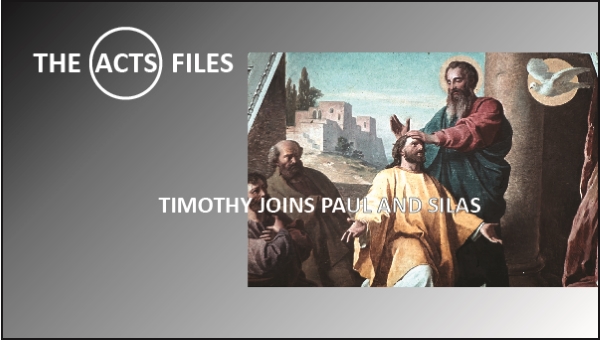By Tyson Thorne

Upon his return to Lystra (Acts 16.1-.5) Paul and Silas meet Timothy, a young man (probably very young, possibly early in his teen years or even younger) who had faith in Jesus the Messiah. Timothy was looked down upon by the cities Jewish population, however, as he is the product of a mixed marriage. While his mother was Jewish, his father was Gentile (and more specifically, Greek). He already had a gift for ministering to others and his godliness was known even among the church at Iconium, a nearby city.
Timothy’s giftedness could not overcome his heritage among the cities practicing Jews. This sounds bigoted and racist, but in truth is based on what the Jews perceived as a rejection of their God-given laws. For instance, the marriage of a Jew to a Gentile is a serious offence not only because of the intermingling of the faithful with the faithless, but because it breaks an important tradition.
From the last days of the Second temple (the second temple was destroyed in 70 AD) to the Age of Enlightenment (and even up until today for some of the more traditional Jewish sects), Jewish marriages were largely arranged by either the family rabbi or a professional matchmaker, called a shadchan. While these arrangements were not binding if one of the children objected, dissent was rare. After the matchmaking came a period of courtship, then betrothal, and finally marriage. This is followed by a ceremony called Nissuin wherein the couple set up house together. All of these traditions were broken by Timothy’s mother when she married someone outside the faith, causing shame and embarrassment to the family.
Furthermore, the concept of marriage in Judaism is based on sanctification. By marrying a Gentile who did not convert to Judaism (as was the case with Timothy’s father), there was no perceived religious legitimacy for the marriage. Instead, it would be the equal of a civil union today. All of this leads up to the rejection of Timothy among the Jewish faithful. Regardless of the reaction of her people, Timothy’s mother raised him with a Jewish education, and later both became followers of the Messiah.
Paul, having been educated at the finest of Jewish universities, wanted to take Timothy with him on the rest of he and Silas’ journey. This would have been a very important part of Timothy’s education and life and was something his parents agreed to. Before they set out, however, there was one order of business Paul wanted to attend to: the circumcising of Timothy.
This has raised some questions among modern Christians. In the chapter before it had been decided – and argued by Paul primarily – that circumcision was not necessary for salvation. The only justification for this act the Luke provides is the cryptic, “[Paul] circumcised [Timothy] because of the Jews”. So Paul required this of Timothy not because it was necessary for salvation, but to gain approval with the Jewish community. At first this seems trivial; why jump through this hoop to appease a community that had already rejected Timothy? In Paul’s way of thinking, it was to remove a barrier that might keep some Jews from hearing the gospel. Which begs the question: what would we do to tell others about our Savior?
The fact that Timothy agreed to undergo the surgical procedure shows how much he cared for the community that had rejected him his whole life. Circumcision requires about four weeks of recovery time when performed on an adult, so while Luke only records five short verses about the apostle’s time in Lystra, Paul and Silas were ministering there for some time.
Timothy would go on to become one of Paul’s best friends and a surrogate son (1 Timothy 1.2). Timothy became a pastor of the church of Ephesus for many years and helped strengthen and grow the church, just as he saw Paul do in the region of Galatia.
The context ends in verse five, which is the fifth progress report Luke provides about the growth of the church.
|
|
|
